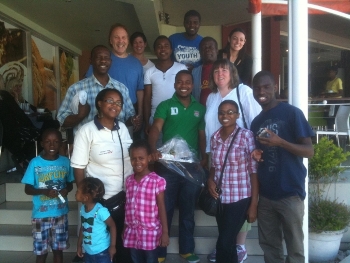Apr 6 2013
What does it take to launch two major international HIV/AIDS research initiatives involving UB and the University of Zimbabwe?
 Group shot at Zimbabwe workshops
Group shot at Zimbabwe workshops
It requires attention to issues as diverse as working with government officials, choosing the right scientists, establishing ethics in research, training for quality control and good laboratory practices, transferring paper patient records into electronic formats and understanding how different cultures respond to serious illness and treatment.
And it requires face-to-face information exchange and planning.
A UB-led research team recently traveled to Zimbabwe to participate in a week-long program of workshops that included the formal launch of two Zimbabwe national programs: the Zimbabwe International Nanotechnology Center (ZINC) and the Zimbabwe Evidence-To-Action (ETA), an implementation project to eradicate HIV/AIDS in Zimbabwe.
With 14 percent of Zimbabwe's population living with HIV/AIDS and tuberculosis as a co-infection, the need for new drugs and new formulations of available treatments is crucial.
UB’s role in the ZINC partnership is to provide training to young scientists and students in Zimbabwe in multiple areas within nanotechnology. The trip to Zimbabwe included identifying research areas of common interest to Zimbabwe and prioritizing them according to the country’s needs.
UB has built a partnership with Zimbabwe over seven years through a National Institutes of Health Fogarty International Center program.
Heading the UB-ZINC collaboration are Paras Prasad, SUNY Distinguished Professor in the departments of Chemistry, Physics, Medicine and Electrical Engineering and Samuel P. Capen Chair of Chemistry, and Gene Morse, professor and associate director of the UB’s New York State Center of Excellence in Bioinformatics and Life Sciences (CoE).
“There was an incredible feeling of optimism and high energy toward both initiatives,” says Morse.
The week began with the second Zimbabwe National Nanotechnology Consultative Meeting on March 18-19.
Prasad, executive director of UB’s Institute for Lasers, Photonics and Biophotonics (ILPB) who will direct the international nanotechnology contributions for ZINC, gave the keynote address.
Morse, who will direct the international nanomedicine component of ZINC, presented the role that UB and the CoE will play in ZINC. Other participating UB faculty members included Stanley Schwartz, SUNY Distinguished Professor in the Department of Medicine, and Peter Horvath, associate professor of exercise physiology and nutrition.
Background and details of ZINC were provided during presentations from the Hon. Professor Heneri Dzinotyiweyi, minister for science and technology development (MSTD); UB alumnus Chiedza Maponga, technical director for nanotechnology (MSTD) and director of the UZ School of Pharmacy; and Josephat Zimba, technical consultant to the MSTD on nanotechnology. Additional presentations from Levi Nyagura, UZ vice chancellor, and David Simbi, vice chancellor, Chinhoyi University of Technology, described the leadership roles for their universities.
The week continued with a two-day workshop on March 20-21 for the ETA Project.
Hosted by the Ministry of Health and Child Welfare, the first day summarized:
-
Recent compelling data that provide the rationale for preventing HIV transmission through pre-exposure prophylaxis (PrEP) and treatment as prevention (TaSP)
-
The national statistics for prevention of mother-to-child transmission and pediatric HIV infection
-
HIV Prevention Trials Network (HPTN) 052 and the dramatic results obtained in discordant couples when the HIV-infected partner was treated early after infection, leading to a reduced transmission rate
-
The need for a strategy to provide treatment to key populations with HIV infection, including high-risk groups such as prisoners, men who have sex with men, commercial sex workers and pregnant women.
At a concurrent workshop, Robin DiFrancesco, manager of the UB Clinical Pharmacology Quality Assurance Program (CPQA) and an AIDS International Training and Research Program (AITRP) mentor, provided lectures focused on building laboratory skills and bioanalytical method development.
In a second afternoon workshop, Kathleen Tooley, senior research support specialist in the UB Translational Pharmacology Research Core, and education and operations administrator for CPQA and AITRP, and an AITRP mentor, moderated a group at the UZ College of Health Sciences to address challenges in research ethics and research administration for faculty and students who will conduct research within ETA.
Morse chaired the second day of the workshop and gave a presentation on the progress of the UB-UZ AITRP. Highlights included a review of the Training Advisory Group and the recently established Scientific Advisory Board, new research programs, nutritional and traditional medicine pharmacology, clinical pharmacology and health care informatics.
The second half of the morning program was chaired by Morse and focused on Bioinformatics and Health Information Technology (HIT) required for the ETA infrastructure in collaboration with the Zimbabwean health care system.
In the HIV Nutrition Pharmacology working group, Horvath and faculty and graduate students from the departments of Pediatrics and Biochemistry discussed nutritional considerations for the ETA project.
Horvath also gave a seminar on March 25 for the UZ departments of Pediatrics and Biochemistry titled “Nutritional Aspects of HIV Infection and Treatment.”
Morse was pleased with the visit.
“I was very proud that a country that has faced so many challenges to advancing the health of the nation and plan for scientific and economic growth was linked to the UB-UZ AITRP and the efforts that have been put forward over the last seven years,” he says.
Morse says the UB team members’ visit contributed to two Zimbabwean national initiatives and conducted numerous sessions, workshops and small group meetings.
“The outcome created a new level of collaboration, reaching beyond university campuses to the highest levels of government ministries, as well as community programs. This extensive spectrum of research and education programs has been built on the strong AITRP link between UZ and UB,” he says.
The events were sponsored jointly by the Zimbabwe Ministry of Health and Child Welfare; the UB-UZ AIDS International Training and Research Program (AITRP) and the UZ-UB International Pharmacotherapy Education and Research Initiative (IPERI).